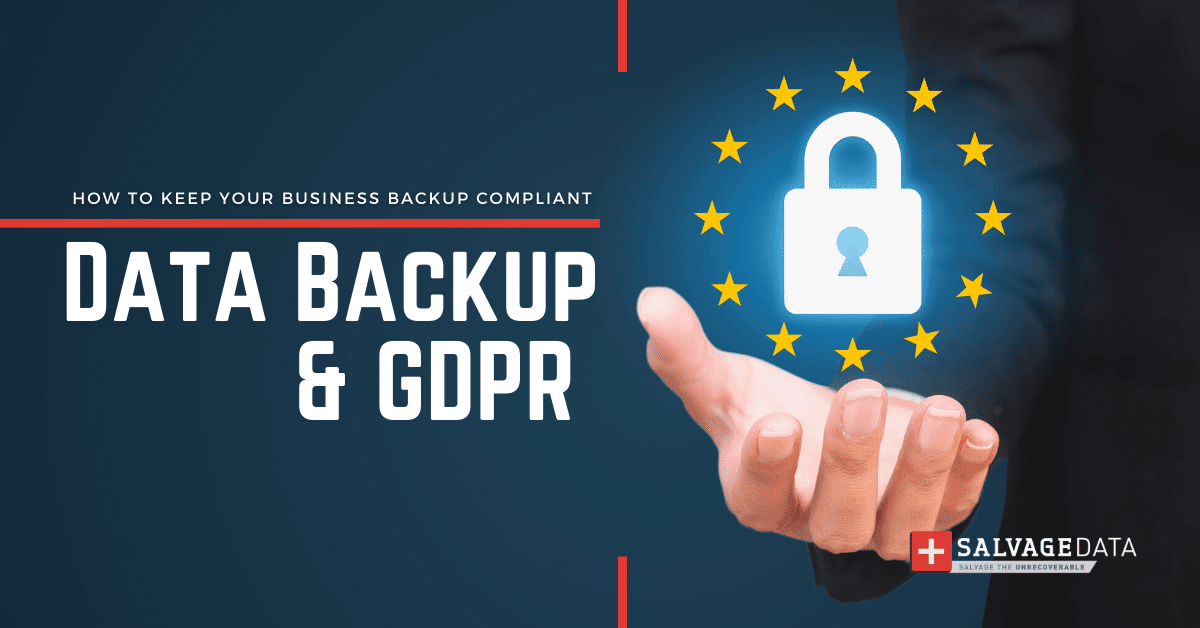Recent Articles
How To Recover Overwritten Files
The Snowflake Data Breach: A Comprehensive Overview
Mac Not Recognizing External Hard Drive: Quick Fix Solutions
How Multi-Cloud Backup Solutions Can Prevent Data Disasters
Capibara Ransomware: What is it & How to Remove
What Should a Company Do After a Data Breach: The Ticketmaster Incident
Secles Ransomware: Removal Guide
What To Do When Your Chromebook Freezes
How to Create Hyper-V Backup
What Is The Best Data Recovery Software For PC

I think there's an issue with my storage device, but I'm not sure Start a free evaluation →
I need help getting my data back right now Call now (800) 972-3282
The General Data Protection Regulation (GDPR) is an EU data protection law that came into effect on May 25, 2018. It replaces the 1995 EU Data Protection Directive. The GDPR regulates the handling of personal data by controllers and processors within the European Union.
Because of the GDPR, every EU citizen has the right to access information about the storage of their personal data. For organizations, this means that they have to find out if they process (for example, collect, record, store, and transmit) personal data. It can be an arduous task especially when you have many data sources and a large part of your data is unstructured.
Any business operating in Europe that collects personal data from EU citizens must follow GDPR requirements for data handling and backup.
This includes understanding what type of personal data you’re collecting, where it’s coming from, and how you’re using their data. GDPR compliance also requires businesses to protect personal data from unauthorized access, destruction, or loss.
How to keep the data backup under GDPR requirements
There are many GDPR-compliant backup solutions available on the market, both on-premises and cloud-based. The best solution for your organization will depend on your specific needs and requirements.
When deciding on your backup solution, you must consider the following aspects to ensure you’re GDPR compliant:
- Understand what type of personal data you are collecting and where it’s coming from
- Take steps to protect the security and confidentiality of personal data
- Take steps to ensure that personal data is accurate and up-to-date
- When there’s no longer the need for data, have a process for deleting or destroying it
- Have powerful and up-to-date antivirus and anti-malware
- Ensure storage device integrity
- Keep more than one backup (both onsite and off-site)
- Collect and store only relevant data
- Have a disaster emergency plan
- Create a system to delete permanently data, that is not needed or upon request from the user
- Clarify for the user how you’re using their data and for how long you’ll store it (such as a legal document the user can access and read)
- Ask the user which data they allow you to access, use, and store
- Always require the user to check they accept your company to access and use their data
- Use high-security standards software and devices to protect the data and keep its confidentiality
- Have compliance reports and let them for easy access by the user
GDPR data backup & storage requirements
The GDPR requires that personal data be stored in a way that ensures its security and confidentiality. One way to do this is to encrypt personal data. Another way to protect personal data is to store it in a secure location, such as a locked file cabinet or safe, as in an off-site backup.
Besides taking measures to protect the security and confidentiality of personal data, businesses must also take steps to ensure that personal data is accurate and up-to-date. This means that businesses must take steps to verify the accuracy of the personal data they collect and update their records as necessary.
Finally, businesses must take steps to ensure that they can delete or destroy personal data when it is no longer needed, or upon user request. This means that businesses must have a process in place for deleting or destroying personal data that is no longer needed.
How to keep your data backup GDPR compliant?
GDPR (General Data Protection Regulation) compliance requires organizations to have strong data backup and recovery practices in place. This is to ensure the privacy and security of personal data in case of a system failure, data corruption, or cyberattack.
The first step in keeping your data backup GDPR compliant is understanding what type of personal data you are collecting and where it is coming from.
Once you have a good understanding of the type of personal data you are collecting, you can take steps to protect it from unauthorized access, destruction, or loss.
Key features of GDPR-compliant backup solutions:
- Encryption: Backup data should be encrypted at rest and in transit using strong encryption algorithms. This ensures that even if unauthorized individuals gain access to the backup files, they won’t be able to read or use the data.
- Access controls: Only authorized personnel should have access to backup data. Strong authentication measures should be implemented to prevent unauthorized access.
- Regular backups: Backups should be conducted regularly according to a defined schedule. This ensures that there is always a recent copy of the data available in case of a disaster.
- Data sovereignty: For organizations located in the EU, it’s important to choose a backup solution that stores data within the EU. This ensures that data is subject to EU data protection laws.
- Data deletion: The GDPR gives individuals the right to erasure, also known as the right to be forgotten. This means that organizations must be able to easily and completely delete personal data from their backups upon request.
GDPR-compliant data backup solutions
There are some GDPR-compliant data backup solutions available on the market today. These solutions typically offer features such as encryption, secure storage, and the ability to delete or destroy personal data any time you have to. This means that your backup must be easy to access and to find and erase personal data. All without damaging other information on the device.
You can use, for example, self-encrypting disks. It requires passwords to access the data and you can keep it locked even if under a ransomware attack.
Pro tip: If you end up losing your business data, you must have a plan to guarantee you can restore it and that the user will not be affected. Meaning, no data leak.
GDPR & data recovery
Under GDPR, individuals may have their personal data erased in certain circumstances. This is known as the “right to be forgotten”. If a user requests to have their data erased, you must delete or destroy the personal data in question. Sometimes, you may also be required to delete or destroy copies of the personal data in question.
Data backup is an important part of any data management strategy. And thanks to the GDPR, now businesses must take steps to ensure that their data backup is GDPR compliant.
If for any reason, from hardware issues to natural disasters, you lose your data, you must find a data recovery service that can restore the data under the GDPR requirements. In other words, a recovery service provider can handle the data with high-security standards.
SalvageData is a certified data recovery service that can provide emergency and secure data recovery, guaranteeing your business stays under GDPR. Contact us 24/7 for emergency data recovery.













